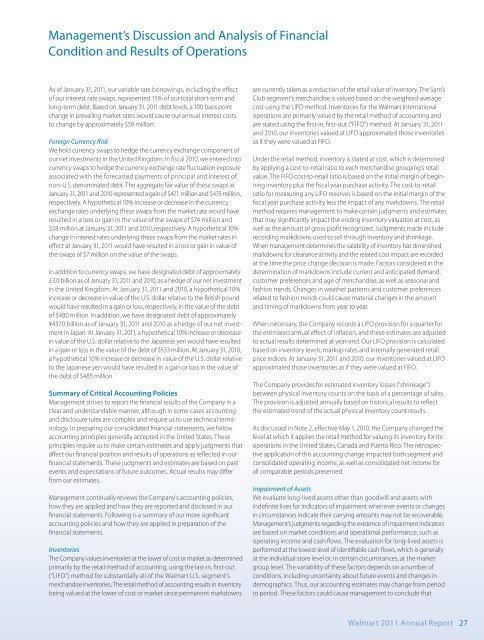Management's Discussion and Analysis of Financial ... - Wal-Mart
Management's Discussion and Analysis of Financial ... - Wal-Mart
Management's Discussion and Analysis of Financial ... - Wal-Mart
- No tags were found...
Create successful ePaper yourself
Turn your PDF publications into a flip-book with our unique Google optimized e-Paper software.
Management’s <strong>Discussion</strong> <strong>and</strong> <strong>Analysis</strong> <strong>of</strong> <strong>Financial</strong>Condition <strong>and</strong> Results <strong>of</strong> OperationsAs <strong>of</strong> January 31, 2011, our variable rate borrowings, including the effect<strong>of</strong> our interest rate swaps, represented 15% <strong>of</strong> our total short-term <strong>and</strong>long-term debt. Based on January 31, 2011 debt levels, a 100 basis pointchange in prevailing market rates would cause our annual interest coststo change by approximately $59 million.Foreign Currency RiskWe hold currency swaps to hedge the currency exchange component <strong>of</strong>our net investments in the United Kingdom. In fiscal 2010, we entered intocurrency swaps to hedge the currency exchange rate fluctuation exposureassociated with the forecasted payments <strong>of</strong> principal <strong>and</strong> interest <strong>of</strong>non-U.S. denominated debt. The aggregate fair value <strong>of</strong> these swaps atJanuary 31, 2011 <strong>and</strong> 2010 represented a gain <strong>of</strong> $471 million <strong>and</strong> $475 million,respectively. A hypothetical 10% increase or decrease in the currencyexchange rates underlying these swaps from the market rate would haveresulted in a loss or gain in the value <strong>of</strong> the swaps <strong>of</strong> $74 million <strong>and</strong>$58 million at January 31, 2011 <strong>and</strong> 2010, respectively. A hypothetical 10%change in interest rates underlying these swaps from the market rates ineffect at January 31, 2011 would have resulted in a loss or gain in value <strong>of</strong>the swaps <strong>of</strong> $7 million on the value <strong>of</strong> the swaps.In addition to currency swaps, we have designated debt <strong>of</strong> approximately£3.0 billion as <strong>of</strong> January 31, 2011 <strong>and</strong> 2010, as a hedge <strong>of</strong> our net investmentin the United Kingdom. At January 31, 2011 <strong>and</strong> 2010, a hypothetical 10%increase or decrease in value <strong>of</strong> the U.S. dollar relative to the British poundwould have resulted in a gain or loss, respectively, in the value <strong>of</strong> the debt<strong>of</strong> $480 million. In addition, we have designated debt <strong>of</strong> approximately¥437.0 billion as <strong>of</strong> January 31, 2011 <strong>and</strong> 2010 as a hedge <strong>of</strong> our net investmentin Japan. At January 31, 2011, a hypothetical 10% increase or decreasein value <strong>of</strong> the U.S. dollar relative to the Japanese yen would have resultedin a gain or loss in the value <strong>of</strong> the debt <strong>of</strong> $533 million. At January 31, 2010,a hypothetical 10% increase or decrease in value <strong>of</strong> the U.S. dollar relativeto the Japanese yen would have resulted in a gain or loss in the value <strong>of</strong>the debt <strong>of</strong> $485 million.Summary <strong>of</strong> Critical Accounting PoliciesManagement strives to report the financial results <strong>of</strong> the Company in aclear <strong>and</strong> underst<strong>and</strong>able manner, although in some cases accounting<strong>and</strong> disclosure rules are complex <strong>and</strong> require us to use technical terminology.In preparing our consolidated financial statements, we followaccounting principles generally accepted in the United States. Theseprinciples require us to make certain estimates <strong>and</strong> apply judgments thataffect our financial position <strong>and</strong> results <strong>of</strong> operations as reflected in ourfinancial statements. These judgments <strong>and</strong> estimates are based on pastevents <strong>and</strong> expectations <strong>of</strong> future outcomes. Actual results may differfrom our estimates.Management continually reviews the Company’s accounting policies,how they are applied <strong>and</strong> how they are reported <strong>and</strong> disclosed in ourfinancial statements. Following is a summary <strong>of</strong> our more significantaccounting policies <strong>and</strong> how they are applied in preparation <strong>of</strong> thefinancial statements.InventoriesThe Company values inventories at the lower <strong>of</strong> cost or market as determinedprimarily by the retail method <strong>of</strong> accounting, using the last-in, first-out(“LIFO”) method for substantially all <strong>of</strong> the <strong>Wal</strong>mart U.S. segment’smerch<strong>and</strong>ise inventories. The retail method <strong>of</strong> accounting results in inventorybeing valued at the lower <strong>of</strong> cost or market since permanent markdownsare currently taken as a reduction <strong>of</strong> the retail value <strong>of</strong> inventory. The Sam’sClub segment’s merch<strong>and</strong>ise is valued based on the weighted-averagecost using the LIFO method. Inventories for the <strong>Wal</strong>mart Internationaloperations are primarily valued by the retail method <strong>of</strong> accounting <strong>and</strong>are stated using the first-in, first-out (“FIFO”) method. At January 31, 2011<strong>and</strong> 2010, our inventories valued at LIFO approximated those inventoriesas if they were valued at FIFO.Under the retail method, inventory is stated at cost, which is determinedby applying a cost-to-retail ratio to each merch<strong>and</strong>ise grouping’s retailvalue. The FIFO cost-to-retail ratio is based on the initial margin <strong>of</strong> beginninginventory plus the fiscal year purchase activity. The cost-to-retailratio for measuring any LIFO reserves is based on the initial margin <strong>of</strong> thefiscal year purchase activity less the impact <strong>of</strong> any markdowns. The retailmethod requires management to make certain judgments <strong>and</strong> estimatesthat may significantly impact the ending inventory valuation at cost, aswell as the amount <strong>of</strong> gross pr<strong>of</strong>it recognized. Judgments made includerecording markdowns used to sell through inventory <strong>and</strong> shrinkage.When management determines the salability <strong>of</strong> inventory has diminished,markdowns for clearance activity <strong>and</strong> the related cost impact are recordedat the time the price change decision is made. Factors considered in thedetermination <strong>of</strong> markdowns include current <strong>and</strong> anticipated dem<strong>and</strong>,customer preferences <strong>and</strong> age <strong>of</strong> merch<strong>and</strong>ise, as well as seasonal <strong>and</strong>fashion trends. Changes in weather patterns <strong>and</strong> customer preferencesrelated to fashion trends could cause material changes in the amount<strong>and</strong> timing <strong>of</strong> markdowns from year to year.When necessary, the Company records a LIFO provision for a quarter forthe estimated annual effect <strong>of</strong> inflation, <strong>and</strong> these estimates are adjustedto actual results determined at year-end. Our LIFO provision is calculatedbased on inventory levels, markup rates <strong>and</strong> internally generated retailprice indices. At January 31, 2011 <strong>and</strong> 2010, our inventories valued at LIFOapproximated those inventories as if they were valued at FIFO.The Company provides for estimated inventory losses (“shrinkage”)between physical inventory counts on the basis <strong>of</strong> a percentage <strong>of</strong> sales.The provision is adjusted annually based on historical results to reflectthe estimated trend <strong>of</strong> the actual physical inventory count results.As discussed in Note 2, effective May 1, 2010, the Company changed thelevel at which it applies the retail method for valuing its inventory for itsoperations in the United States, Canada <strong>and</strong> Puerto Rico. The retrospectiveapplication <strong>of</strong> this accounting change impacted both segment <strong>and</strong>consolidated operating income, as well as consolidated net income forall comparable periods presented.Impairment <strong>of</strong> AssetsWe evaluate long-lived assets other than goodwill <strong>and</strong> assets withindefinite lives for indicators <strong>of</strong> impairment whenever events or changesin circumstances indicate their carrying amounts may not be recoverable.Management’s judgments regarding the existence <strong>of</strong> impairment indicatorsare based on market conditions <strong>and</strong> operational performance, such asoperating income <strong>and</strong> cash flows. The evaluation for long-lived assets isperformed at the lowest level <strong>of</strong> identifiable cash flows, which is generallyat the individual store level or, in certain circumstances, at the marketgroup level. The variability <strong>of</strong> these factors depends on a number <strong>of</strong>conditions, including uncertainty about future events <strong>and</strong> changes indemographics. Thus, our accounting estimates may change from periodto period. These factors could cause management to conclude that<strong>Wal</strong>mart 2011 Annual Report 27





